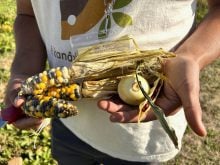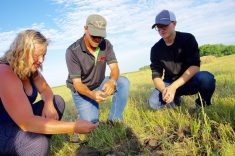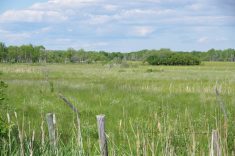Imagine adding one thing to a field and suddenly, as well as producing food, it also generates building materials, fuel and fodder. At the same time, this change would nourish the health of the soil, regulate the micro-climate and support pest-controlling wildlife like beneficial insects. Or maybe that addition could produce a whole other crop.
That’s the promise of agroforestry, a mode of production that doesn’t just cover intercropping trees and annual crops, but also extends globally to options like shrubs, palms and bamboo.
On a large scale, agroforestry could help mitigate climate change by storing more carbon in land that can still serve other purposes. Countries can even count trees planted on farmland toward their reforestation commitments.
Read Also

New ranking elevates Assiniboine College to national research elite
Brandon’s Assiniboine College is 47th in a national ranking measuring research dollars and output at publicly funded institutions in Canada.
There is a lot of scope for planting trees on farms in south Asia and sub-Saharan Africa, but a lot of these farms are small – on average, less than two hectares. Any potential use of space has to earn its keep.
So, how do we ensure trees work for both farmers and the planet? India, where the last two decades have seen phenomenal changes in agroforestry, offers insight and warnings.
India’s first effort to get more trees on farms started in 1999 with the Lok Vaniki scheme in Madhya Pradesh, a state in central India. The state government started the initiative to help farmers with degraded land secure additional income from timber. It provided them with saplings of teak.
The project had a troubled start. The Indian supreme court had banned all tree felling except for what was permitted under the forest working plan three years earlier. Before farmers could sell the timber they grew, their request to fell the tree had to be approved by the government.
Farmers were understandably apprehensive about planting something they may not get permission to harvest. Plus, teak trees take 20 years to yield timber. A cumbersome process for obtaining permits and high transport costs for small and marginal farmers scuppered the scheme.
The state responded by exempting certain trees from felling regulations. By 2014, India had a national agroforestry policy that offered farmers saplings and simpler procedures for harvesting and transporting trees.
Still, the tree cover on farms didn’t budge. In fact, the last decade has seen a severe decline in trees on farms in India, according to one study I contributed to.
The decline was pronounced among mature trees. Once, these gnarled veterans had shaded open wells on farms and kept water from evaporating in the sun’s glare. Now, deeper bore wells could be dug, rendering such trees obsolete.
The expansion of mechanized farming put a premium on treeless fields, where tractors and farm vehicles could easily manoeuvre. Attacks by fungal parasites claimed other trees.
Some farmers were unsentimental. In interviews, many said they saw few benefits from trees, which could prevent sunlight from reaching crops. But the decline of native trees like neem, mahua and jamun, once prized for their medicinal oils and nutritious fruit, threatened rural diets, particularly in the poorest regions.
While farmland trees dwindled across India, block plantations, which grew nothing but trees, expanded.
These plantations largely comprise exotic and fast-growing trees like eucalyptus, poplar and casuarina, which are all exempt from felling regulations. Enticed by the prospect of generating carbon credits on the international carbon market and by demand for pulpwood for making paper, farmers with some of the smallest plots in India tried switching their crops to block plantations.
When the price of carbon credits dropped with the collapse of the UN’s clean development mechanism in 2012, these small farmers were left with little to show for it. A study later confirmed that many would have been better off keeping their land for conventional agriculture.
Although there is increasing demand for pulpwood and timber in India, it is likely to favour farmers who can plant in large areas, cover harvest and transit costs, and wait for returns from plantations – a situation small and marginal farmers can ill afford.
These exotic plantations are no boon for the environment either. For instance, eucalyptus consumes a lot of water and soil nutrients, leaving the land less fertile for future cultivation. Its leaves and flowers are less useful to birds than many native trees.
There is a rush globally to plant more trees on farms without considering what farmers will do with the tree in 20 years, or how it may interfere with crop production. This problem is not unique to India and has been noted elsewhere, including Kenya.
Trees should still be encouraged on farms; preferably native trees that are beneficial for local diets and medicine. So far, though, the trend in India and elsewhere has been toward block plantations of exotic trees, a phenomenon largely driven by the lure of carbon credits.
The focus should be on supporting small and marginal farmers to grow native trees sustainably. Scattered trees of many species on small farms have bigger benefits for farmers and the environment than single-species plantations.
For that to happen, though, there has to be some way of financing this process. If carbon credit mechanisms can recognize this model of agroforestry and help small farmers add trees to their cropland, it would be a big shift in the right direction.
– This article first appeared in the Conversation, by Reuters.















